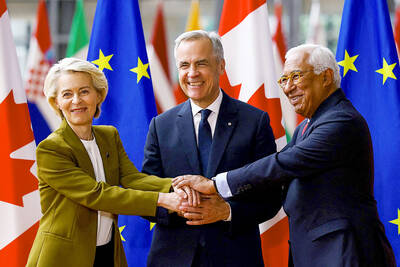Falling birth rates will slow the world’s Muslim population growth over the next two decades, reducing it on average from 2.2 percent a year from 1990 to last year to 1.5 percent a year from now until 2030, a new study says.
Muslims will number 2.2 billion by 2030, compared with 1.6 billion last year, making up 26.4 percent of the world population compared with 23.4 percent now, according to estimates by the Pew Forum on Religion and Public Life.
The report did not publish figures for worldwide populations of other major religions, but said the US-based Pew Forum planned similar reports on growth prospects for worldwide Christianity, Hinduism, Buddhism, Sikhism and Judaism.

Photo: AFP
“The declining growth rate is due primarily to falling fertility rates in many Muslim-majority countries,” it said, noting the birth rate is falling as more Muslim women are educated, living standards rise and rural people move to cities.
“Globally, the Muslim population is forecast to grow at about twice the rate of the non-Muslim population over the next two decades — an average annual growth rate of 1.5 percent for Muslims, compared with 0.7 percent for non-Muslims,” it said.
The report, titled The Future of the Global Muslim Population, was part of a Pew Forum program analyzing religious change and its impact on societies around the world.
It said about 60 percent of the world’s Muslims would live in the Asia-Pacific region in 2030, 20 percent in the Middle East, 17.6 percent in sub-Saharan Africa, 2.7 percent in Europe and 0.5 percent in the Americas.
Pakistan will overtake Indonesia as the world’s most numerous Muslim nation by 2030, it said, while the Muslim minority in mostly Hindu India will retain its global rank as the third-largest Muslim population.
Continued migration will swell the ranks of Europe’s Muslim minorities by one-third by 2030, to 8 percent of the region’s inhabitants from 6 percent, it said.
Muslims in France will rise to 6.9 million, or 10.3 percent of the population, from 4.7 million (7.5 percent), in Britain to 5.6 million (8.2 percent) from 2.9 million and in Germany to 5.5 million (7.1 percent) from 4.1 million (5 percent).
The Muslim share of the US population will grow from 0.8 percent last year to 1.7 percent in 2030, “making Muslims roughly as numerous as Jews or Episcopalians are in the United States today,” the study said.
By 2030, Muslims will number 2.1 million, or 23.2 percent of the population, in Israel — including Jerusalem, but not the West Bank and Gaza — after 1.3 million (17.7 percent) last year.
“The slowdown in Muslim population growth is most pronounced in the Asia-Pacific region, the Middle East-North Africa and Europe, and less sharp in sub-Saharan Africa,” it said, while migration will accelerate it in the Americas through 2020.
While Muslim populations worldwide are still younger on average than others, the so-called “youth bulge” — the high percentage of Muslims in their teens and 20s — peaked around the year 2000 and is now declining,” the study said.
Sunni Muslims will continue to make up the overwhelming majority in Islam — about 87 to 90 percent, the report estimated — while Shi’ite numbers may decline because of relatively low birth rates in Iran, where one-third of all Shiites live.
The study saw a close link between education and birth rates in Muslim-majority countries. Women in countries with the least education for girls had about five children, while those where girls had the longest schooling averaged 2.3 children.
The study said it counted “all groups and individuals who self-identify as Muslims,” including secular or non-observant people, without measuring levels of religiosity.
It said measuring the impact of Islam on birth rates was difficult because “cultural, social, economic, political, historical and other factors may play equal or greater roles.”

‘SHORTSIGHTED’: Using aid as leverage is punitive, would not be regarded well among Pacific Island nations and would further open the door for China, an academic said New Zealand has suspended millions of dollars in budget funding to the Cook Islands, it said yesterday, as the relationship between the two constitutionally linked countries continues to deteriorate amid the island group’s deepening ties with China. A spokesperson for New Zealand Minister of Foreign Affairs Winston Peters said in a statement that New Zealand early this month decided to suspend payment of NZ$18.2 million (US$11 million) in core sector support funding for this year and next year as it “relies on a high trust bilateral relationship.” New Zealand and Australia have become increasingly cautious about China’s growing presence in the Pacific

The team behind the long-awaited Vera Rubin Observatory in Chile yesterday published their first images, revealing breathtaking views of star-forming regions as well as distant galaxies. More than two decades in the making, the giant US-funded telescope sits perched at the summit of Cerro Pachon in central Chile, where dark skies and dry air provide ideal conditions for observing the cosmos. One of the debut images is a composite of 678 exposures taken over just seven hours, capturing the Trifid Nebula and the Lagoon Nebula — both several thousand light-years from Earth — glowing in vivid pinks against orange-red backdrops. The new image

ESPIONAGE: The British government’s decision on the proposed embassy hinges on the security of underground data cables, a former diplomat has said A US intervention over China’s proposed new embassy in London has thrown a potential resolution “up in the air,” campaigners have said, amid concerns over the site’s proximity to a sensitive hub of critical communication cables. The furor over a new “super-embassy” on the edge of London’s financial district was reignited last week when the White House said it was “deeply concerned” over potential Chinese access to “the sensitive communications of one of our closest allies.” The Dutch parliament has also raised concerns about Beijing’s ideal location of Royal Mint Court, on the edge of the City of London, which has so

Canada and the EU on Monday signed a defense and security pact as the transatlantic partners seek to better confront Russia, with worries over Washington’s reliability under US President Donald Trump. The deal was announced after a summit in Brussels between Canadian Prime Minister Mark Carney and European Commission President Ursula von der Leyen and European Council President Antonio Costa. “While NATO remains the cornerstone of our collective defense, this partnership will allow us to strengthen our preparedness ... to invest more and to invest smarter,” Costa told a news conference. “It opens new opportunities for companies on both sides of the